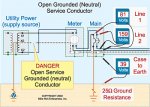Yes that makes sense. How about 120/240 V single phase system, here the neutral (center point of transformer secondary) is grounded; I have heard that if the connection of neutral to ground breaks at the pole, the 120 V in the house will become 240 V and will damage the equipment.
Consider that 120/240V single phase is the same as a multi-wire branch circuit (MWBC). Two ungrounded conductors paired with a grounded conductor. Normally Line->Neutral loads see 120V or close to it. However, if you lose the neutral between the panel and the xfmr*, the connected 120V loads now operate in series instead of parallel. Instead of 120V on each leg, you could have anywhere from 10-230V (theoretically 0-240V however it is ultra rare to have most 120V loads connected to one leg). Obviously your refrigerator motor isnt going to like 10 or 230V, or fluctuating voltage that isnt +/-10% of 120V. Electronics can catch fire.
If you'd like to see the effects of a lost neutral, use 2 shop lights with different wattage bulbs on a MWBC and lift the neutral in the panel (make sure nothing else is on this circuit, and do it in your own home!). If you have 2 60W bulbs plugged in, you will not see a change (or an incredibly small one brightness wise) as each one has an equal voltage drop across it. Change them to a 20W and 100W bulb, and one will glow brightly for a second before it blows the filament, then the other, not having a complete circuit at that point, will go off. This is assuming you arent using a GFCI outlet which will probably be a $20 paperweight after such a test.
240V loads like water heaters are not affected by a lost neutral since they lack one anyway and are already connected L-L. It doesnt matter if L-L is 0-240, 120-120, 240-0, 175-65V, etc
*If the home has metal water pipes and proper bonding, the loss of the POCO neutral will not insta-blow electronics. Current can flow thru the pipes, thru your neighbors pipes, and thru his service neutral back to the xmfr. The cable co's coax connection can also serve as a neutral, tho not for very long. If you ever see fried coax, better check it before replacing it.
eta: Golddigger covered much of this far less wordily.


